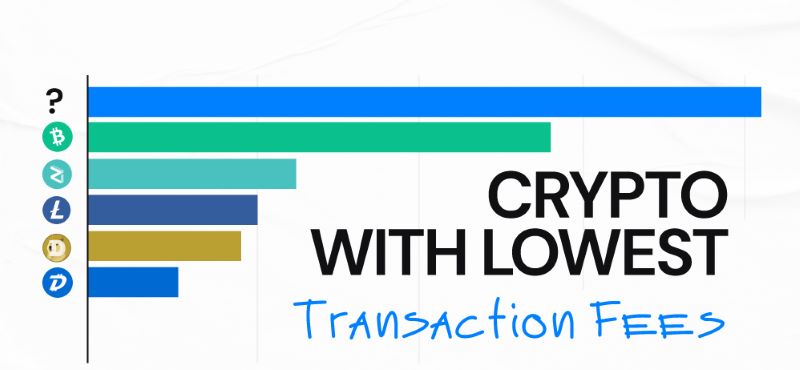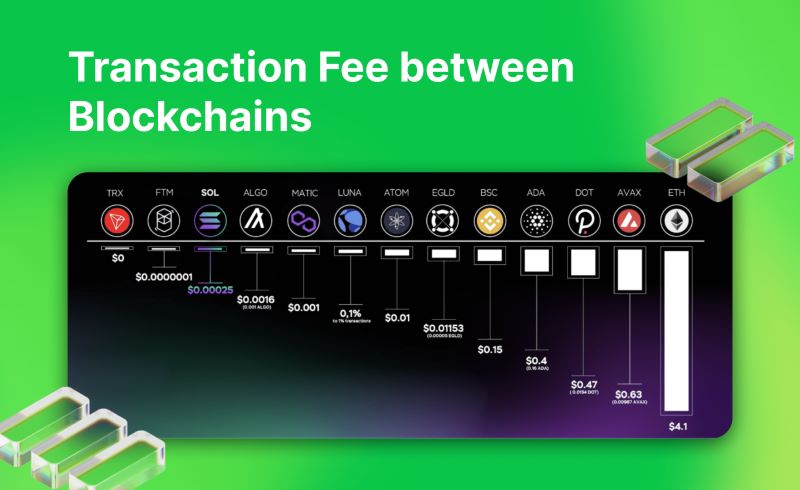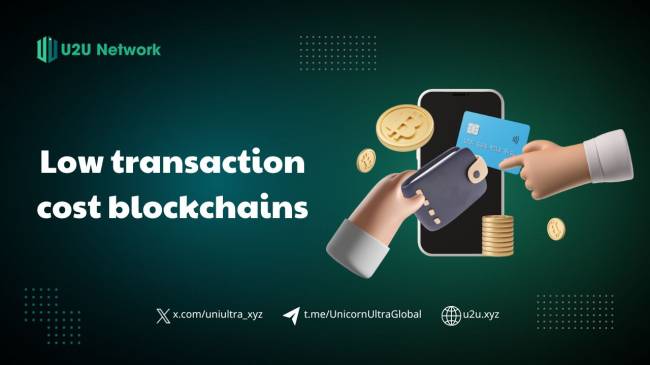High transaction fees have long been a barrier to the widespread adoption of blockchain technology. However, the emergence of low transaction cost blockchains is changing the game. These innovative platforms are not only making blockchain more accessible for everyday users but are also fueling the growth of Web3, the decentralized internet. By significantly reducing transaction costs, these blockchains are empowering developers to create new and exciting applications, from decentralized finance (DeFi) to social networking platforms like U2U Network. This article delves into the world of low transaction cost blockchains, exploring their benefits, the technologies that make them possible, and their potential to revolutionize the digital landscape.
Table of Contents
Why Low Transaction Costs Matter
Low transaction costs are pivotal in unlocking blockchain technology's full potential, addressing long standing barriers to its mainstream adoption. While blockchain offers decentralization, security, and transparency, high transaction fees have historically hindered its widespread use, particularly on networks like Ethereum where gas fees can skyrocket during periods of congestion.
Reducing Barriers to Adoption
Low transaction cost blockchains are reshaping this landscape by significantly lowering the expense of conducting transactions. This accessibility is critical for expanding blockchain's utility across various applications and industries. By alleviating cost concerns, these blockchains can foster broader adoption and drive innovation.

Enabling New Use Cases
Low transaction costs are particularly beneficial for several key use cases:
- Micropayments: Affordable fees enable frequent small transactions, facilitating new monetization models for content creators, social platforms, and more.
- Decentralized Finance (DeFi): DeFi platforms rely on low costs to offer accessible financial services such as lending, borrowing, and trading, leveling the playing field for global participation.
- Gaming and NFTs: The gaming industry and NFT market thrive on low fees, enabling seamless in-game transactions, NFT creation, and trading without excessive overhead.
- Financial Inclusion: Reduced transaction costs can revolutionize financial services for underserved populations, enabling access to essential services like remittances and payments in developing regions.
A Catalyst for Innovation
The advent of low transaction cost blockchains is fueling a wave of innovation within the Web3 ecosystem. Developers and entrepreneurs are liberated from high fee constraints, allowing them to pioneer new applications that were previously economically impractical. This surge in creativity is diversifying the blockchain landscape, expanding its potential for real-world impact and fostering a more inclusive digital economy.
How Blockchains Achieve Low Transaction Costs
Achieving low transaction costs on blockchains involves a strategic combination of innovative technologies and optimizations across different layers of the blockchain architecture. Here's a detailed breakdown of how these approaches work together:
Consensus Mechanisms: The Foundation of Efficiency
Proof of Stake (PoS): PoS replaces energy-intensive mining with validators who validate transactions based on the tokens they stake. This reduces energy consumption significantly compared to Proof of Work (PoW), leading to lower transaction fees. PoS also tends to offer faster block times and higher throughput, enhancing efficiency and reducing costs further.
Other Consensus Mechanisms: Alternatives like Delegated Proof of Stake (DPoS) and Proof of Authority (PoA) offer different approaches. DPoS uses elected delegates for transaction validation, often resulting in faster and cheaper transactions. PoA relies on a limited number of trusted validators, suitable for consortium or private blockchains where transaction costs can be tightly controlled.
Layer 2 Solutions: Scaling Beyond the Base Layer
Rollups: These solutions execute transactions off-chain and then bundle them into a single transaction submitted to the main chain. By reducing the computational load on the main blockchain, rollups significantly lower fees and accelerate transaction times.
State Channels: Similar to rollups, state channels enable multiple transactions to occur off-chain between parties. Only the final state of these transactions is recorded on the blockchain, minimizing on-chain transactions and thus reducing fees.

Sharding: Dividing and Conquering
Sharding: This technique divides the blockchain into smaller segments (shards) that operate independently, processing their own set of transactions. Sharding increases the network's capacity and throughput by allowing parallel processing, which leads to lower transaction costs. Blockchains like NEAR Protocol use sharding to achieve scalability and efficiency.
Other Optimizations
Block Size Adjustments: Increasing block sizes allows more transactions per block, reducing congestion and lowering fees during peak usage periods.
Fee Market Mechanisms: Dynamic fee markets adjust transaction fees based on network demand, optimizing costs by incentivizing users to pay higher fees when necessary and lower fees during off-peak times.
Compression Techniques: Compressing transaction data reduces the amount of data stored and processed on the blockchain, effectively lowering fees.
U2U Network: A Case Study in Low-Cost Blockchain Innovation
U2U Network exemplifies groundbreaking innovation in decentralized social networking, distinguished by its utilization of Directed Acyclic Graph (DAG) technology and compatibility with the Ethereum Virtual Machine (EVM). This strategic framework prioritizes user autonomy, data ownership, and seamless scalability within its rapidly expanding community.
How U2U Capitalizes on Minimal Transaction Costs
Enabling Microtransactions for Content Creators: U2U's inventive infrastructure, combined with the innate efficiency of DAG technology, facilitates exceptionally low transaction fees. This empowers users to effortlessly reward creators with even the smallest cryptocurrency amounts, nurturing a dynamic creator economy where each contribution holds value. This stands in stark contrast to conventional social media platforms, where creators often grapple with monetization challenges due to exorbitant platform fees or ad-driven models.
Accessible Social Engagements: U2U extends its low transaction costs across all platform interactions. Users can message, like, share content, and participate in various social activities without incurring substantial fees. This fosters active engagement and removes financial barriers to communication, positioning U2U as a more inclusive and accessible platform for all users.
Seamless Scalability for Expansion: As U2U's community continues to grow, its DAG-based chain and Subnet technology ensure effortless scalability. U2U can accommodate millions of users without compromising performance or encountering the network congestion typical of traditional blockchains. This scalability is crucial for U2U's ambition to establish itself as a mainstream social platform that competes effectively with centralized alternatives.
The Future of Low Transaction Cost Blockchains
Low transaction cost blockchains represent not just a technical enhancement but a catalyst driving the Web3 revolution forward. By eliminating the financial barriers that historically hindered blockchain adoption, these networks are empowering developers, entrepreneurs, and users to fully embrace the potential of decentralized technologies.
Fueling the Web3 Revolution
Web3, heralded as the next evolution of the internet, rests on principles of decentralization, user ownership, and trustless interactions. Low transaction cost blockchains play a pivotal role in realizing this vision by facilitating the creation of decentralized applications (dApps) and services that can scale effectively, devoid of the prohibitive costs that plagued earlier blockchain platforms.

Unleashing New Horizons
Low transaction fees open avenues for a spectrum of new dApps and services, sparking innovations such as micropayments, decentralized social networks, DeFi applications, gaming and NFT ecosystems, and IoT applications. These advancements democratize access to financial services, enhance digital content monetization, and enable innovative business models without intermediary barriers.
Navigating Challenges and Seizing Opportunities
While the prospects for low transaction cost blockchains are promising, several challenges must be addressed:
- Scalability: Efficiently scaling to handle growing transaction volumes without compromising speed or cost-effectiveness is crucial.
- Security: Robust security measures are imperative to safeguard user assets and data, ensuring trust and reliability in blockchain ecosystems.
- Interoperability: Seamless interoperability between different blockchains is crucial for fostering a cohesive Web3 landscape, enabling enhanced communication and interaction across decentralized platforms.
In conclusion, the emergence of low transaction cost blockchains is fundamentally reshaping the digital landscape, unlocking the full potential of Web3 and empowering innovative platforms such as U2U Network. Positioned as a decentralized social network operating on a cost-efficient blockchain, U2U exemplifies the transformative impact of affordable transactions. By facilitating microtransactions for content creators, enabling seamless social interactions, and ensuring scalability for its expanding user base, U2U vividly illustrates the tangible benefits of this technological advancement.
These blockchains represent more than just a technical upgrade; they serve as catalysts for a more inclusive and accessible Web3 ecosystem. By lowering financial barriers, they empower individuals and communities to actively engage in the digital economy, freely create and share content, and develop decentralized applications without being constrained by prohibitive fees. U2U Network, committed to user empowerment and community-driven innovation, stands at the forefront of this movement, harnessing low-cost blockchains to deliver a fairer and more enriching social media experience.
As the Web3 landscape evolves, low transaction cost blockchains will continue to play a pivotal role in shaping its trajectory. Platforms like U2U Network, embracing and leveraging this technology, are positioned as leaders in fostering a decentralized, user-centric, and financially inclusive internet. The era dominated by high transaction fees is giving way to a new era characterized by accessibility and innovation, thanks to the ascendancy of low transaction cost blockchains.





.png)
